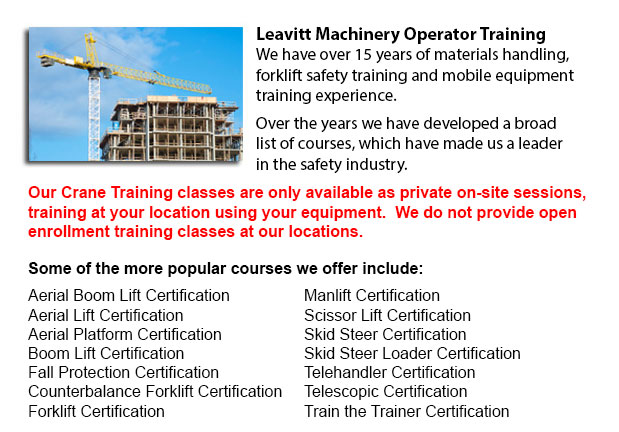
Brampton Overhead Crane Operator Training - Our overhead crane operator training course is designed to teach employees the basics of overhead crane/sling operation and pre-shift checks. Courses are taught by our professional trainers and consultants. Well-trained workers are more productive and efficient, which actually saves on expenses connected with property damage, merchandise damage, and accidents due to the use of improper operating procedures. Our overhead crane certification is customized for staff who have literacy barriers, reducing certification time by 50 percent.
Overhead cranes are suitable for particular repetitive lifting activities. This kind of crane has wide ranging capacities. They may be used for specialized hoisting tasks such as removing or installing major plant machines.
Worker and operators need to employ safe rigging practices to be able to safely operate an overhead crane. This will require both practice and knowledge because the load needs to be correctly rigged to ensure its stability when hoisted. Prior to starting a hoisting job, it should be determined that the crane is suitable for the job, with right travel, lift and capacity. The crane should be subjected to a thorough visual and physical inspection before utilization. The capacity of all machines, including the slings, hardware and rope, must never exceed load weight capacities.
The rigger has to know the correct sling for each and every lift and check slings and other rigging hardware before utilizing. Clear signals should be used in communications with the crane operator. A signaler has to be chosen for the role and signals must be agreed upon. The crane operator needs to follow instructions from the chosen individual only. If a wired or remote controller is being used, the operator must be trained in all its functions.
To ensure the safety of employees, a warning must be issued and the path of the load must be cleared of all hazards before the lift begins. Individuals must not be allowed to walk beneath the lift loads. The crane hoist must be centered over the load prior to hoisting in order to prevent swinging. The safety catch needs to be closed instantly after sliding the sling entirely onto the lifting hook. Unused sling legs must be secured so they do not drag. Never leave loose materials on a load being hoisted. Watch that fingers and hands are clear when slack is taken out of a sling. Step clear of the danger zone before the lift is carried out.
-
Brampton Aerial Boom Lift Ticket
Brampton Aerial Boom Lift Ticket - Aerial lift trucks might be used to accomplish several different tasks executed in hard to reach aerial places. Many of the tasks associated with this style of jack include performing routine maintenance on building... More -
Brampton Aerial Lift Train the Trainer
Brampton Aerial Lift Train the Trainer - The Aerial Lifts Train the Trainer Certification Program would teach trainers how to efficiently train operators in safe industrial mobile equipment operation. Trainers are provided with in-depth instruction o... More -
Brampton Zoom Boom Training
Brampton Zoom Boom Training - Zoom Boom Training is intended to train operators on variable reach forklifts. The goals of the training are to be able to impart an understanding of the physics of the machinery, and to be able to outline the operator's... More -
Brampton Heavy Equipment Operator Training
Brampton Heavy Equipment Operator Training - Heavy equipment operator training facilities that provide good standards within the industry, providing field performance work and additional machinery training are really sought after training features. S... More -
Narrow Aisle Forklift / Order Picker Training / Electric Pallet Jack / Electric Pallet Truck Training in Brampton
A pallet haul is equipment built in particular for moving pallets of irregular weights and dimensions. They may be used in conjunction with cranes, forklifts and other heavy duty equipment as an appendage piece or to be employed on their own. Pallet... More -
Brampton Overhead Crane Safety Training
Brampton Overhead Crane Safety Training - Overhead crane safety training equips operators with knowledge and skills regarding crane safety measures, accident avoidance, materials handling, and equipment and stock protection. Trainees will learn the k... More -
Brampton Crane Safety Training
Brampton Crane Safety Training - Companies and crane drivers have to know the problems associated to crane safety. Legislation provides rules for the safe maintenance, operation and inspection of lifting machines across North America. Crane Safety co... More -
Brampton Telehandler Training
Brampton Telehandler Training - Telescopic handlers normally known as telehandlers for short, are a really popular piece of heavy construction machinery. They are usually utilized in the construction and agricultural trades. These machines have farth... More

Forklift Certification Brampton
TOLL FREE: 1-888-254-6157
Brampton, Ontario
forkliftcertificationbrampton.com
Email Us
About Us


